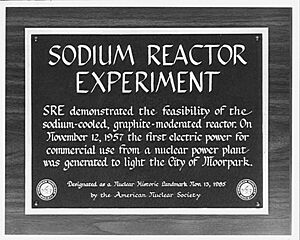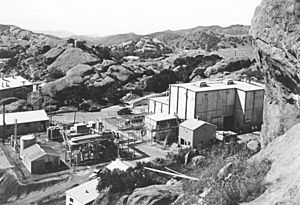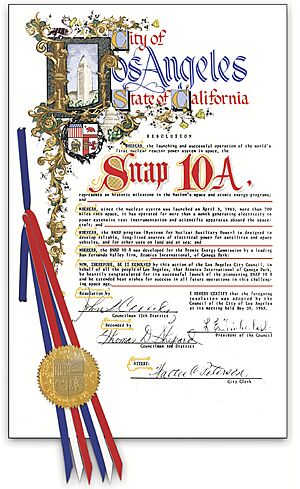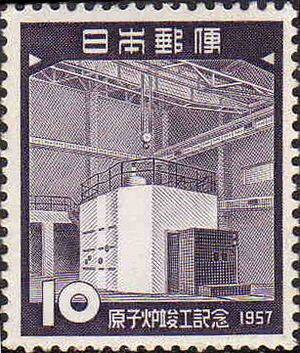Atomics International facts for kids
 |
|
| Industry | Nuclear energy and related technology |
|---|---|
| Fate | merger |
| Successor | Energy Systems Group Division of Rockwell International |
| Founded | 1955 |
| Defunct | 1978 |
| Headquarters | Canoga Park, California 34°13′44″N 118°42′50″W / 34.229°N 118.714°W |
|
Key people
|
Chauncey Starr |
|
Number of employees
|
9,000 |
| Parent | North American Aviation (1933–1967) |
Atomics International was a special part of the North American Aviation company. This company later joined with Rockwell International. Atomics International focused on creating new nuclear technology and nuclear reactors. They built these for both businesses and the government.
They achieved many important things in nuclear energy:
- They designed, built, and ran the first nuclear reactor in California in 1952.
- They created the first nuclear reactor to produce electricity for a public power grid in the United States in 1957.
- They launched the first nuclear reactor into space for the United States in 1965.
Atomics International started developing nuclear reactors soon after it was formed. They worked on commercial nuclear power reactors, like the Sodium Reactor Experiment (SRE). They also made small nuclear reactors, such as the Systems for Auxiliary Nuclear Power (SNAP-10A) system. Both projects were successful, even though there were some incidents at the Santa Susana Field Laboratory.
Over time, people became less interested in nuclear power. So, Atomics International began working on other energy projects, like turning coal into gas. They slowly stopped designing and testing nuclear reactors. Eventually, Atomics International joined with another part of Rockwell International called Rocketdyne.
By 2010, most of Atomics International's buildings were taken down, cleaned up, and reused. Only a few buildings remain at the Santa Susana Field Laboratory (SSFL) in Area IV, waiting for final cleanup.
Contents
Atomics International: A Brief History
After World War II, the U.S. Government and the public became very interested in nuclear power. In 1948, North American Aviation created a special group called the Atomic Energy Research Department (AERD). This group managed all their nuclear research and development.
The AERD designed and built a small 5-watt reactor in Downey, California. On April 21, 1952, this became the first nuclear reactor to operate in California. In 1955, the AERD changed its name to the Atomics International division of North American Aviation.
The Sodium Reactor Experiment (SRE)
Atomics International wanted to make nuclear power reactors that could produce electricity for businesses. They decided to use sodium as a nuclear reactor coolant instead of water. Sodium is great because it transfers heat very well, doesn't need high pressure at normal reactor temperatures, and melts easily. Water, on the other hand, needs strong pipes and special containers because it's kept under high pressure at hot reactor temperatures.
The company gained a lot of experience from their nuclear technology work. This helped them design, build, and run the Sodium Reactor Experiment (SRE). On July 12, 1957, the SRE became the first nuclear reactor in the U.S. to send electricity to a public power grid. It powered homes in the nearby city of Moorpark.
In July 1959, there was an incident. Some cooling channels inside the reactor's fuel parts got blocked by a substance. This caused 13 out of 43 fuel elements to partially melt. Atomics International workers fixed the reactor. It started running again in September 1960 and operated until 1964.
The company also designed other experimental reactors for the Atomic Energy Commission. These included a sodium-cooled unit for the Hallam Nuclear Generating Station in Nebraska and an organic-cooled unit for the Piqua Nuclear Generating Station in Ohio. Both of these reactors had technical problems and only ran for a few years before being shut down.
SNAP: Power for Space and More
The development of small nuclear reactors for the Systems for Nuclear Auxiliary Power (SNAP) program happened at the same time as the SRE project. In the mid-1950s, Atomics International was chosen to lead the U.S. Government's effort to develop these compact SNAP reactors. Many special buildings were built at the Santa Susana Field Laboratory for this work.
In 1965, the SNAP 10A reactor was successfully launched into space. After this, the U.S. Government ended the program. Many government-owned facilities were left at the site. In 1966, the Liquid Metal Information Center (later called the Energy Technology Engineering Center) was created. It reused many of the buildings from the SNAP program for liquid metal research.
Other Nuclear Projects and Changes
Atomics International also worked on other projects for businesses. They built and ran the Atomics International Hot Lab at the Santa Susana Field Laboratory. This lab took apart fuel rods to help with research on SNAP reactors. It also removed coverings from fuel rods from other nuclear reactors. Atomics International also developed a way to turn coal into gas using molten salt technology.
As years passed, less nuclear research was being done. Because of this, Atomics International was combined with other parts of Rockwell International in 1978. It became the Energy Systems Group. Atomics International was no longer a separate business, but its remaining work continued under the Atomics International name within the Energy Systems Group.
In 1984, the remaining Atomics International work joined the Rocketdyne division of Rockwell International. Nuclear research stopped in 1989, and all non-nuclear research ended in 1998. In 1996, Rockwell International sold Rocketdyne to The Boeing Company. Boeing kept ownership of the Santa Susana Field Laboratory property, including Area IV, and is responsible for cleaning it up.
Where Atomics International Worked
Atomics International started in Downey, California. Then, it moved to several places in the western part of California's San Fernando Valley in Canoga Park. Since all their facilities dealt with radioactive materials, there are records about what happened at each site.
Downey Facility
The Atomic Energy Research Development Group started at the North American Aviation plant in Downey, California. They did basic research and built a reactor called the Water Boiler Neutron Source. This reactor was moved to the Santa Susana Field Laboratory in 1955. The Downey facility was later given to the City of Downey, and the buildings were replaced with new commercial buildings.
Vanowen Boulevard Facility
Atomics International had a building in Canoga Park, next to the Rocketdyne facility. Here, they worked on fuel for the SNAP program and did radiochemistry. They also supported two small reactors. By 1960, both reactors were closed, and radioactive materials were removed. Atomics International moved its headquarters, and the Vanowen building was taken down in 2007.
De Soto Avenue Facility
In 1959, Atomics International set up its main office at a group of buildings on De Soto Avenue in Canoga Park. This facility had a small reactor, made nuclear reactor fuel, and had a lab for working with radioactive materials. All operations involving radioactive materials were removed by the mid-1990s. Today, Aerojet Rocketdyne owns this property.
Santa Susana Field Laboratory (SSFL), Area IV
From 1953 to 1989, three main types of work happened in Area IV of the Santa Susana Field Laboratory (SSFL) in the Ventura County Simi Hills:
- Developing and testing nuclear reactors.
- Supporting nuclear operations.
- Non-nuclear energy research at the Energy Technology Engineering Center.
The research done by Atomics International caused some radioactive contamination in Area IV. The U.S. Department of Energy has agreed to clean up both chemical and radioactive impacts in Area IV. In 2009, the U.S. Environmental Protection Agency started a large survey to find out how much radioactive contamination was there.
Nuclear Reactor Development and Testing
Between 1954 and 1980, several nuclear reactors and test setups were built and operated in Area IV of the Santa Susana Field Laboratory. Test setups are very low-power reactors that don't need active cooling.
- Advanced Epithermal Thorium Reactor
This reactor was built in 1960 to test different reactor core designs. The program ended in 1972.
- Homogeneous Water Boiler-type Reactors
Atomics International designed small nuclear reactors (5 to 50,000 watts) for research, training, and making isotopes. These reactors used a special liquid fuel. They didn't actually boil, but tiny bubbles of hydrogen and oxygen formed, making it look like they were boiling. One reactor model, the L-54, was bought by many universities and research groups, including Japan. The Japanese Atomic Research Institute called theirs Japan Research Reactor-1 (JRR-1). In 1957, the Japanese government even made a postage stamp to celebrate Japan's first nuclear reactor! This reactor was shut down in 1970 and is now a museum exhibit in Tokaimura, Japan.
- Sodium Reactor Experiment (SRE) Program
The Sodium Reactor Experiment (SRE) was an experimental nuclear reactor that ran from 1957 to 1964. On July 12, 1957, it made history by producing the first electricity from a nuclear power system to supply a commercial power grid in the U.S., powering homes in Moorpark. In July 1959, an incident occurred where cooling channels got blocked, causing some fuel parts to partially melt. Atomics International fixed the reactor, and it ran again from September 1960 until 1964.
- Systems for Nuclear Auxiliary Power (SNAP) Program
The SNAP program started in 1955. Its goal was to create small, light, and reliable atomic electric devices for space, land, and sea. The Atomic Energy Commission (AEC) was in charge of getting these devices for the Department of Defense and National Aeronautics and Space Administration. From 1955 to 1973, the U.S. spent about $850 million to develop SNAP nuclear reactors.
Atomics International was the main company working with the AEC on SNAP reactors. In the late 1950s and early 1960s, Atomics International built many government-owned facilities at the Energy Technology Engineering Center (ETEC) in Area IV of the Santa Susana Field Laboratory (SSFL). The SNAP-10A was the only nuclear reactor launched and tested in flight by the United States. The City of Los Angeles even gave Atomics International an award for this achievement.
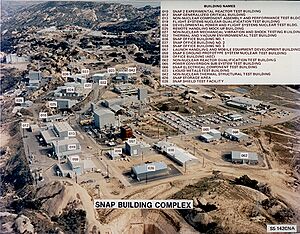
| Name | Full Name | Dates of Operation | Power (kWth) | Building Number |
|---|---|---|---|---|
| SER | SNAP Experimental Reactor | Sep 1959 – Dec 60 | 50 | 010 |
| SDR a.k.a. S2DR | SNAP (2) Developmental Reactor | Apr 61 – Dec 62 | 65 | 024 |
| S8ER | SNAP 8 Experimental Reactor | May 63 – Apr 65 | 600 | 010 |
| SNAP 10A FS-3 | Duplicate of launched SNAP 10A FS-4 | Jan 65 – Mar 66 | 38 | 024 |
| S8DR | SNAP 8 Developmental Reactor | Jun 68 –Dec 69 | 600/1000 | 059 |
- Nuclear Support Operations
At the Santa Susana Field Laboratory, about twenty facilities were built in Area IV to handle radioactive materials. This supported the nuclear reactor programs. These operations included making, storing, and reprocessing fuel, measuring radiation, and preparing radioactive waste for disposal. As of 2010, only the Radioactive Materials Handling Facility is still used for cleanup efforts.
ETEC: Energy Technology Engineering Center
The Energy Technology Engineering Center (ETEC) focused on testing parts that were designed to move heat from a nuclear reactor using liquid metals instead of water or gas. Atomics International ran the ETEC as a separate division at SSFL under a contract with the U.S. Department of Energy. The ETEC operated from 1966 to 1998.
Additional Information
- The DOE's former Energy Technology Engineering Center Project website has lots of historical and current cleanup information.
- The California Department of Toxic Substances Control SSFL Site Investigation and Cleanup website also provides details.
- You can see a timeline of nuclear-related activities conducted in SSFL Area IV using an interactive graphic.
- A detailed history for each SSFL Area IV building is in the 2005 Historical Site Assessment document.
- The US Environmental Protection Agency also created a Historical Site Assessment for SSFL Area IV.


